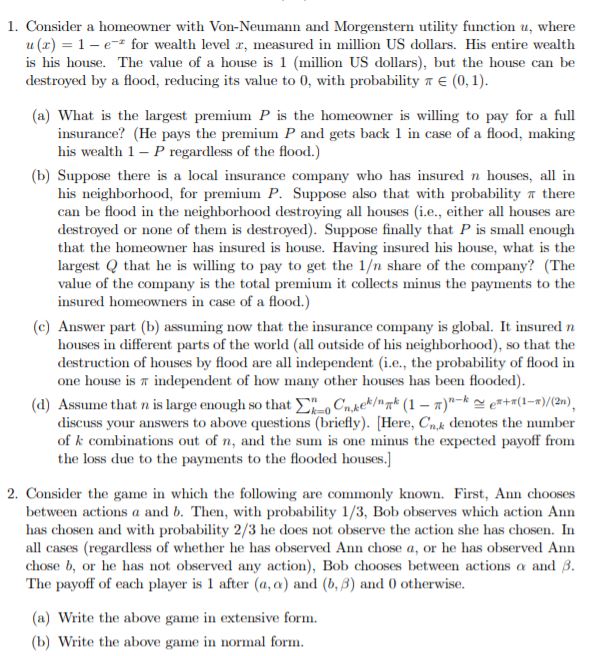Question
1. Alice and Bob have inherited a factory from their parents. The value of the factory is vA for Alice and vB for Bob, where
1. Alice and Bob have inherited a factory from their parents. The value of the factory is vA for Alice and vB for Bob, where vA and vB are independently and uniformly distributed over [0, 1], and each of them knows his or her own value. Simultaneously, Alice and Bob bid bA and bB, respectively, and the highest bidder wins the factory and pays the other sibling's bid. (If the bids are equal, the winner is determined by a coin toss.) Find a symmetric, linear Bayesian Nash equilibrium of this game.
2. An object is to be sold to one of n bidders through a first-price auction. The value of object for bidder i is vi ? 0, which is privately known by the bidder i. The values (v1,...,vn) are independently and identically distributed with probability density function f and cumulative distribution function F. Make this formally as a Bayesian game and compute the symmetric Bayesian Nash equilibria in increasing differentiable strategies.
3. There are n hunters. Simultaneously each hunter chooses between Stag and Rabbit. If a hunter chooses Rabbit, his payoff is ? regardless of what other hunters do. If he chooses Stag, he gets v> 0 if at least k other hunters also choose Stag and gets 0 otherwise. The possible values for ? is [a, b] where av.
(a) Assume that ? is known and compute the set of pure strategy Nash equilibria.
(b) Assume that ? is not known. Each player i observes a signal
xi = ? + ??i
where 0 min {?a, b ? v} and (?1,...,?) are independently and identically dis-
n
tributed with uniform distribution on [?1, 1]. Find the set of symmetric, monotone Bayesian Nash equilibria. (That is, find the possible values for a cutoff x?such that each player i chooses Stag if and only if xi ? x?in equilibrium.)
Hint: By symmetry, the probability that xi is the mth highest among (x1,...,xn) is 1.
(c) Briefiy discuss your answers.
4. Alice owns a car, and Bob may buy it. The car can be a Lemon or a Peach. Alice knows whether it is Lemon or Peach, while Bob assigns probability 1/2 to each case. The value of a Lemon is $1,000 for Alice and $3,000 for Bob, and the value of a Peach is $5,000 for Alice and $10,000 for Bob. Alice sets a price p ? P, and Bob decides whether to accept the price. If the price is accepted, they trade the car at price p; no trade occurs otherwise. For each set P below find a sequential equilibrium and verify that it is indeed a sequential equilibrium.
(a) P = {2000, 7000}
(b) P = [0,?).
Consider the repeated game with the following stage game. A unit mass of kids are uniformly located on a street , denoted by the [0, 1]interval. There are two ice cream parlors namely1 and2 located at 0and1, respectively. Each ice cream parlor i sets a price pi for its own ice cream, simultaneously, where p-bar>0. A kid located in w is to pay cost c|w?y| to go to a store located at y, where c ? (0, p-bar/3). Given the prices p1 and p2, each kid buys one unit of ice cream from the store with the lowest total cost, which is the sum of the price and the cost to go to the store. (If the total cost is the same, she flips a coin to choose the store to buy.)
a)Assume that the above game is repeated 100times, and find the subgame-perfect Nash equilibria.
b)(b)Assume that the above game is repeated infinitely many times and the discount rate is??(1/3, 1). For each of the following strategy profile, find the highest p? under which the strategy profile is a subgame-perfect Nash equilibrium. (Here, p? may be a function of ?. You need to choose both p? and p? to make the strategy profile a subgame-perfect Nash equilibrium.)
1.At the beginning each parlor I chooses pi=p? and continues to do so until some player sets a different price; each i selects price thereafter. 2.There are two states: Collusion and War. The game starts at the state Collusion. In Collusion state, each player i chooses pi=p?, and in War state each player i chooses pi=p? If both players set the price prescribed for the state, then the state in the next round is Collusion; the state in the next round is War otherwise. 3.Bonus:In part (ii), assume that p??0 but war can last multiple periods. State such a strategy profile formally and answer the above question for such a strategy profile.

Step by Step Solution
There are 3 Steps involved in it
Step: 1

Get Instant Access to Expert-Tailored Solutions
See step-by-step solutions with expert insights and AI powered tools for academic success
Step: 2

Step: 3

Ace Your Homework with AI
Get the answers you need in no time with our AI-driven, step-by-step assistance
Get Started


